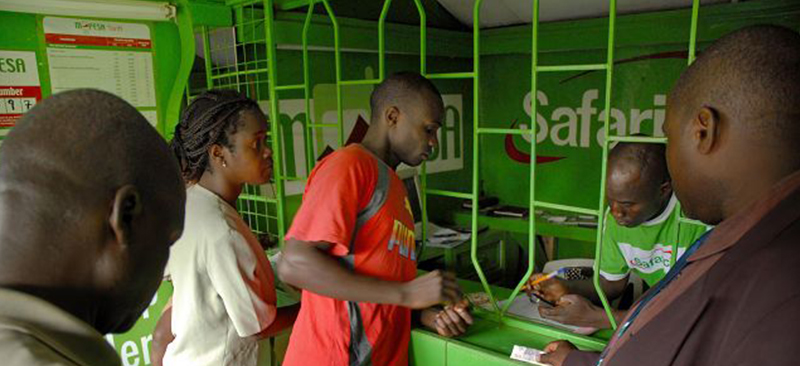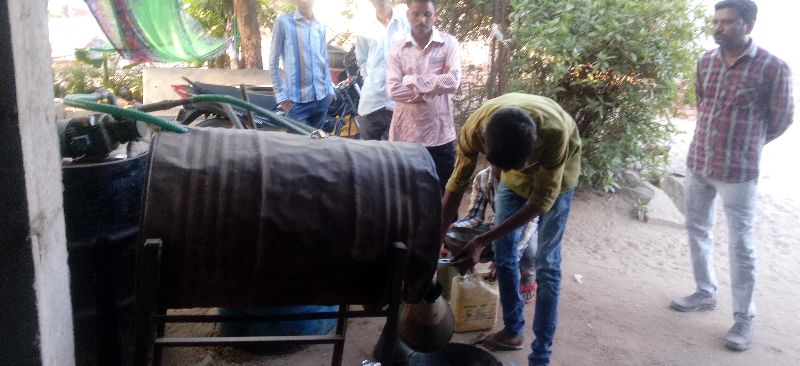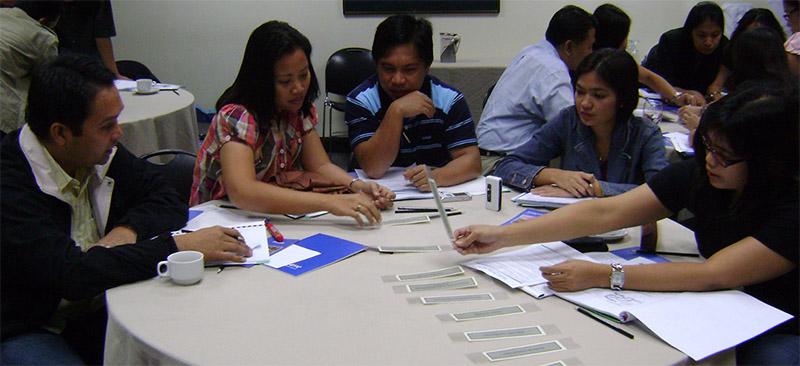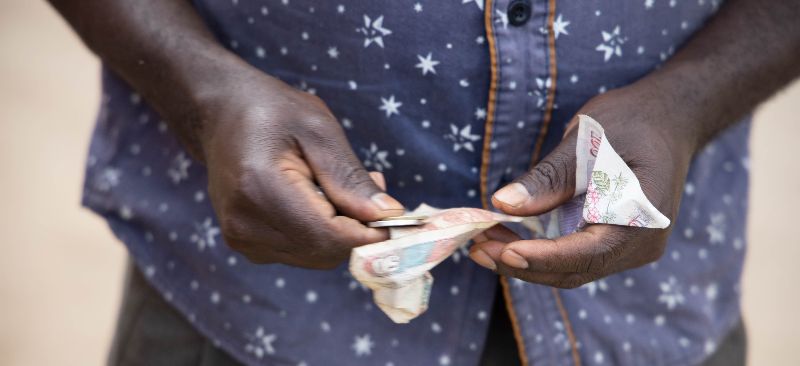This Note highlights the efforts of TSPI in the Philippines to develop productivity incentives to support the growth of their TSPI Palayan (Rice) Programme (TPP). TPP is now offered in 92 branches with outreach to 15,000 clients and a loan portfolio of PhP369 million (US$8.2 million) as of December 2013. In 2013, TSPI embarked on an expansion campaign targeted at increasing TPP productivity. Early results from the pilot test of the incentives, which resulted in increased outreach as well as portfolio quantity and quality, encouraged TSPI to extend the campaign to succeeding cropping seasons.
Blog
Mobile Money Agents in Uganda: Sprinting ahead, but the marathon’s not yet over
With 50% of cash-in/cash-out agents conducting at least 30 transactions per day, it is evident that Uganda is one of the world’s leading digital finance markets. However, despite its impressive growth, many operational challenges still persist. The Helix Institute of Digital Finance’s ‘Agent Network Accelerator Survey: Uganda Country Report 2013’ (conducted by MicroSave and the Bill & Melinda Gates Foundation) analyses both the operational factors of success, and residual challenges in agent network management in the country. Here I highlight four key findings from the report and discuss their implications for market maturity and the direction of its future development.
72% of agents are located within 15 minutes of a rebalancing point.
Unfortunately, this is not a positive indicator, but a result of agents having trouble surviving outside of areas where rebalancing is quick and cheap – along the road network and near financial institutions (see similar findings here in Tanzania). To extend the reach of the networks farther, time must be spent on resolving major operational issues such as liquidity management, monitoring and support.
This problem of ‘liquidity tethering’, (see Emerging Trends for Agent Networks in 2014), is prevalent across the industry. Looking at Uganda, where 43% of the entire population, and only 34% of the poor population, live within 5km radius to a financial access point, increasing the geographical reach of agent rebalancing services will be key to creating a ubiquitous and genuinely inclusive digital financial sector in the country.
Profits are high with 40% of agents making at least US$100 of profits a month.
Although agents are generally happy with their financial gains, data shows they could be earning significantly higher profits. With a median of ten transactions per day being denied due to service downtime, b Ugandan agents could increase their daily transactions by 33%, if this issue was addressed. Although similar challenges plague the industry internationally, researchers were surprised by how much it was affecting the ability to serve customers in Uganda.
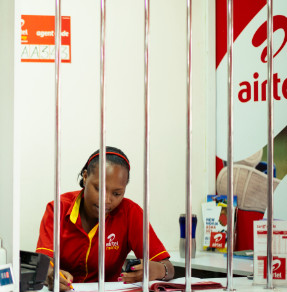 This issue, however, can also be seen as a symptom of the industry’s rapid growth and success, as transaction volumes regularly overwhelm platforms that were not designed for such scale.
This issue, however, can also be seen as a symptom of the industry’s rapid growth and success, as transaction volumes regularly overwhelm platforms that were not designed for such scale.
Changing or updating platforms is a costly and lengthy process with which providers are currently struggling. In the meantime, providers need to focus on minimising the impact at the agent level by giving them timely and accurate warning about system downtime.
Agencies are “new”, with more than half having been in business for less than one year.
Once again this figure may come as a surprise due to the maturity of the Ugandan market. Data shows this high percentage of nascent agents is a result of both rapid growth and agent churn (agency’s closing and tills being given to other agents). However, be it growth or churn, the large number of inexperienced agents in the market undoubtedly impacts the quality of service delivery. (Further research will need to be done to distinguish the level of contribution of each factor.)
Given agents are the face of the brand, and can play an important role in building trust in the system, the issue becomes – how do you cost effectively train them, and then monitor and support them in the field given many have a short life-cycle? Here, incisive agent selection is key, as is strategically spending monitoring and support budgets as the agents mature.
Banking services (credit, savings and insurance) are almost non-existent.
According to Pew Research, in Uganda 50% of cell phone owners regularly make or receive payments on their phone. Further, InterMedia reports half of households registered with mobile money store money on their m-accounts, meaning the country is already at a level of maturity where people feel comfortable leaving a little float on the system.
 However, innovation of new products in Uganda remains almost completely absent, leaving agents primarily doing cash-in and cash-out. Bill pay and airtime top-ups are available, but mostly over the handsets, and integration with banking services is recent, and not being offered on the agent level at scale.
However, innovation of new products in Uganda remains almost completely absent, leaving agents primarily doing cash-in and cash-out. Bill pay and airtime top-ups are available, but mostly over the handsets, and integration with banking services is recent, and not being offered on the agent level at scale.
Opportunities for product innovation, which would increase the amount of transactions each registered customer does on the system, are abound and agents can play an important role in selling them to the mass market, if providers strategically include them.
Click here to read the ‘Agent Network Accelerator Survey: Uganda Country Report 2013’ in full, and delve deeper into the data on Uganda’s operational factors for success and opportunities for improvements as the market moves into its next stage of maturity.
Don’t Throw the Baby Out with Bathwater
2013 could have been a watershed year for G2P (government to person) transfers as the Government of India (GoI) decided to use the Aadhaar unique identification system for Direct Benefit Transfers (DBTs). However, the recent decision to suspend the DBT scheme for liquid petroleum gas LPG cylinders (popularly known as DBTL) seems set to reverse this. What went wrong in the 12 months since the launch of this ambitious scheme, prompting the GoI to suspend implementation completely? We need to understand the context and dissect the process of DBT to assess this. There is evidence that Aadhaar-based DBT brought in efficiencies wherever a supportive eco-system was provided. Aadhaar-based DBT needs more sustained and coordinated effort from local government, banks and business correspondents to realise its potential.
Repositioning as a Third Generation Microfinance Institution Corporate Branding at ASKI
Microfinance institutions often suffer from the stigma of being viewed primarily as lending institutions, in spite of offering a range of financial and non-financial services. This perception is rooted in the fact that lending has been, and still remains, the core business of these institutions making it extremely difficult to change the perception. Corporate branding is essential for the success of MFIs – particularly those that seek to move beyond traditional core micro-credit business. In this Note we present the case of ASKI, a development NGO in the Philippines, which grappled with these issues and how it developed a corporate branding strategy.
District readiness for G2P payments: Ready or not… Well, still mostly ‘not’ part – II
The previous blog in this series highlighted the complexity of setting up a system to deliver electronic benefit transfers (EBT) effectively in India. And how there seemed to be little rationale for the selection of districts for pilot-tests and rollout of Aadhaar-enabled EBTs. We suggested the need for a tool that helps governments to decide which districts to choose for DBT roll out depending on districts’ readiness level? And, that such a tool may also help us all to understand which areas need focus for successful rollout?
In response, MicroSave has developed “district readiness assessment” (DRA) tool, to assess the readiness of a district to deliver EBTs.
The DRA tool was pilot-tested in two districts in East Uttar Pradesh. It was used to assess these districts’ readiness to make payments under the Mahatma Gandhi National Rural Guarantee Scheme (MGNREGS) and ASHA (Accredited Social Health Activist) schemes. The readiness of stakeholders was assessed on different indicators, and the preliminary key findings are summarised below:
- CICO Coverage: In both the districts, the number of agents actually present is far lower than the number provided in the State Level Bankers Committee(SLBC) or different banks’ websites. Out of a list of 673 agents (as available from secondary sources), only 124 could be found available and ready for transactions (i.e. agents are physically present in their location with front-end technology to allow account opening and transactions). If seen in the context of total villages of over 1,000 population, this comes to minuscule 4%. This is in line with a recent study on the availability of agents in rural areas. Further, it is unclear whether these agents will have enough liquidity to service customers, an aspect that most agents have not thought about and the parent bank/agent network manager has not asked them to prepare for.
- CICO Quality: CICO quality is measured in terms of service delivery, complaint resolution and capacity building of CICO agents, and it was found far from satisfactory in the two districts that were surveyed. The few agents working in these districts were not well trained, and were ill-equipped to handle customer queries, and resolve issues. The graph below shows scores to highlight the difference between the desirable and actual situation on a 0-5 range, with 5 being actual equals desirable, and 0 being actual completely fails to meet the desired level of service.
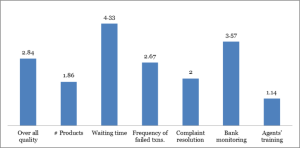
- CICO Sustainability: The majority of the CICO agents who were available were not able to earn even 40% of what they expected from the banking business to run CICO outlet viably. This has an adverse effect on their motivation to continue in the long run. This is a matter to concern because a large number of agents have already gone dormant or have quit the business because of low returns. If more agents stop offering the CICO services, beneficiaries will be left with no choice but to go to bank/post office branches and of course trust in the system will decline significantly.
- Department-Bank Readiness: In case of MGNREGS, complete beneficiary data is digitized and each beneficiary is mapped to one account; but many of these accounts are not mapped to only one beneficiary. In many cases, payment to multiple beneficiaries is mapped/ transferred to one single account. This defeats the purpose of EBT, which envisages that an individual’s benefits be paid directly to him/her. For ASHA payment, the situation is worse as data is not digitized and the payments are processed on the basis of manual vouchers.
- Beneficiary Awareness: This is one area that should have preceded DBT roll out, but it seems that no efforts were made by any stakeholder, or that the efforts were ineffective. In both the districts, more than 70% of beneficiaries are not aware of bank-CICO linkage; and over 80% do not know that G2P payments can also be received through such CICO agents. This is, of course, not surprising given that there are so few CICO agents in the two districts.
Preliminary results of the DRA clearly suggest that the districts are not ready for efficient implementation of G2P programme. There are important gaps in individual stakeholder level preparations, and the coordination between the stakeholders is very weak. A better approach to roll out of G2P payments in any location is to assess the readiness of different stakeholders, systems, and infrastructure and then make a decision. If the scores on different parameters are too low, the government should first address the challenges before rollout. DRA report gives ample data and information along with analysis and recommendations that can form the basis of corrective measures.
For successful implementation of EBT, all the stakeholders need to come together and make concerted efforts instead of working in silos; and will need to have data on the readiness of districts to deliver G2P effectively.
Cash Transfers: Impact and New Trends
In this podcast, Sakshi Chadha and Nicola Giordano explain the transformative potential of cash transfers around the world. In particular, they focus on how digitisation of cash transfers can bring improvements in process delivery, hence realising development outcomes more efficiently and effectively. To achieve this aim, MSC is currently engaged with CICO networks in the roll out of G2P payments in India and across the world.

